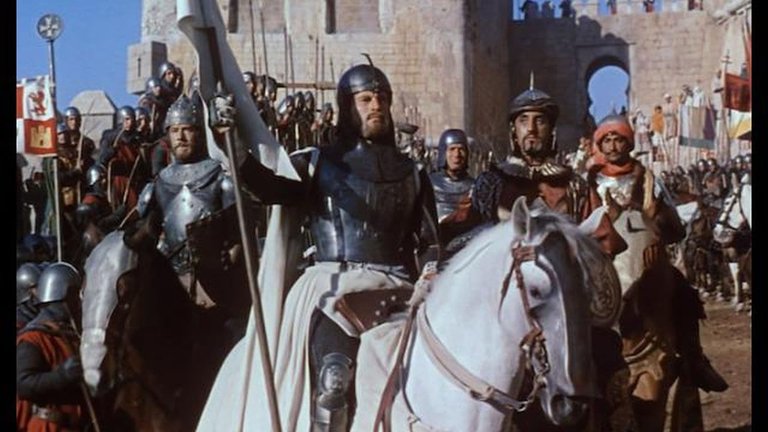
When nostalgic cinephiles lament the absence of “Hollywood films that they don’t make any more,” they often refer to the grand, larger-than-life historical epics that studios produced in the 1950s and 1960s. These films aimed to deliver vibrant colours and sweeping vistas in a widescreen format, offering audiences a spectacle that was unattainable in the confines of their small black-and-white television sets. Among these cinematic treasures, one of the most highly regarded is El Cid, a 1961 historical epic directed by Anthony Mann.
El Cid loosely reconstructs the life of Don Rodrigo Díaz de Vivar, known as El Cid, an 11th-century Castilian knight and warlord revered as a national hero in Spain. The plot begins in 1080, during a time when the Iberian Peninsula was divided between Christians and Moors. The film introduces viewers to Don Rodrigo (played by Charlton Heston), a knight serving King Ferdinand of Castile (played by Ralph Truman). He is portrayed as a man who transcends religious divides; after defeating a Moorish raid, he releases captured Moorish emirs, one of whom, al-Mut’amin of Zaragoza (played by Douglas Wilmer), becomes his lifelong friend and ally. However, his marriage to Chimene (played by Sophia Loren) is marred by conflict with her father Gormaz (played by Andrew Cruikshank), and his refusal to engage in dynastic disputes between Ferdinand’s heirs—Sancho (played by Gary Raymond) and Alfonso (played by John Fraser)—leads to his exile. Despite this, he ends up leading an army against the fanatical North African warlord Ben Yusuf (played by Herbert Lom), who threatens to conquer all of Spain.
Creating epic films about monumental figures like El Cid presents filmmakers with the daunting challenge of condensing decades of significant events into a feature-length narrative. Even with a runtime exceeding three hours, such films can sometimes feel incomplete or rushed. The screenplay for El Cid was crafted by several authors amid chaotic pre-production circumstances; nevertheless, the final result is largely satisfactory. The writers drew from scant historical records, the famous 12th-century epic poem, and Corneille’s 17th-century play to create a blend of romance and melodrama that ultimately forms a coherent whole.
Creating epic films about monumental figures like El Cid presents filmmakers with the daunting challenge of condensing decades of significant events into a feature-length narrative. Even with a runtime exceeding three hours, such films can sometimes feel incomplete or rushed. The screenplay for El Cid was crafted by several authors amid chaotic pre-production circumstances; nevertheless, the final result is largely satisfactory. The writers drew from scant historical records, the famous 12th-century epic poem, and Corneille’s 17th-century play to create a blend of romance and melodrama that ultimately forms a coherent whole.
Audiences were primarily drawn to the film's grand spectacle, which featured not only stunning Spanish locations but also thousands of extras and impressive battle scenes. Many resources were provided by the Spanish government, eager to utilise cinema as a means to promote country’s emerging tourism industry. Interestingly, Francisco Franco interpreted El Cid as an allegorical representation of himself, drawing parallels between saving Spain from ideological fanatics in the 11th century and his own actions during the Spanish Civil War.
Anthony Mann’s direction displays remarkable skill, particularly evident in the film's action sequences. The battles set on the beaches of Valencia establish a high standard for epic filmmaking that few subsequent films have matched. The climactic scene where Don Rodrigo sacrifices himself and rides into legend remains one of the most memorable moments in early 1960s Hollywood cinema.
Mann benefited from exceptional cinematography by Robert Krasker and an evocative score by composer Miklos Rozsa. Rozsa’s extensive research into Spanish medieval music allowed him to craft one of the most effective film scores of his career.
However, Mann faced challenges with the film’s dramatic scenes, particularly those exploring the troubled romance between Don Rodrigo and Chimene. This lack of chemistry can be partly attributed to casting choices; while Charlton Heston embodies the heroic archetype well, his interactions with Sophia Loren lack depth. Reports suggest that both actors struggled to get along on set, which may have contributed to their unconvincing romantic dynamic. Additionally, the character of Dona Urraca (Genevieve Page) is poorly developed; introduced as a romantic rival for Chimene, she serves little purpose beyond being eye candy for those viewers who might not find Loren appealing.
Despite these shortcomings—alongside Martin Scorsese’s assertion following a 1993 restoration that El Cid is perhaps the greatest epic film ever made—Mann’s work remains commendable for fans of the genre. It offers not only nostalgia for those yearning for films that “aren’t made any more” but also an engaging cinematic experience that showcases both spectacle and drama
RATING: 7/10 (+++)
Blog in Croatian https://draxblog.com
Blog in English https://draxreview.wordpress.com/
InLeo blog https://inleo.io/@drax.leo
Hiveonboard: https://hiveonboard.com?ref=drax
Rising Star game: https://www.risingstargame.com?referrer=drax
1Inch: https://1inch.exchange/#/r/0x83823d8CCB74F828148258BB4457642124b1328e
BTC donations: 1EWxiMiP6iiG9rger3NuUSd6HByaxQWafG
ETH donations: 0xB305F144323b99e6f8b1d66f5D7DE78B498C32A7
BCH donations: qpvxw0jax79lhmvlgcldkzpqanf03r9cjv8y6gtmk9
Posted Using InLeo Alpha